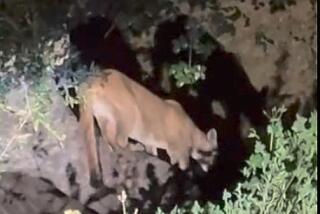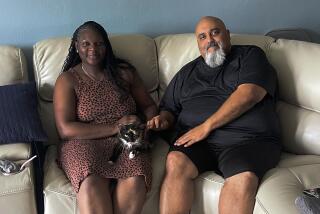Fox Is Guinea Pig : Rare Critter Undergoes Experimental Laser Treatment at UC Irvine for Cancerous Tumor
- Share via
IRVINE — Fauna, a rare Santa Catalina Island fox found partially blind and wandering near Avalon Airport 11 years ago, underwent experimental laser surgery at UC Irvine on Wednesday for cancer in an ear.
The five-pound fox, who became a local celebrity after she was rescued in 1984, recently developed a tumor the size of a golf ball in her right ear.
For her human friends, the cancer discovery was upsetting, because Fauna, at age 13, is the oldest known living urocyon littoralis catalinae. She has become popular among tourists on the island, where a special habitat was built for her near Avalon Airport, and she even accompanies naturalists for campfire talks.
A conventional operation three months ago failed to eradicate the tumor, which returned--this time as a large pink mass protruding from her right ear.
Her only chance for survival lay in the hands of Dr. George Peavy, veterinary director at UCI’s Beckman Laser Institute and Medical Clinic, where experimental diode lasers are being used to remove cancers.
The procedure, called photodynamic therapy, or PDT, has not been approved by the FDA for use on humans and still is being developed by scientists at the Beckman Institute and Lawrence Livermore National Laboratory.
“Without a procedure of this kind, she wouldn’t stand a chance,” Peavy said.
A photosensitive dye was injected into Fauna’s bloodstream Monday night that traveled through the fox’s body and permeated the cancerous tissues.
“We still don’t know why the dye remains only on the cancer cells,” said Anne Rosse, director of development at the Beckman Institute. “We have theories, but nothing definite.”
At 10 a.m. Wednesday, Fauna was taken into a small operating room where she was put in a clear anesthetic chamber, slightly larger than her frame, and a gas form of anesthesia was pumped into the chamber through a tube.
Donning surgical masks, head covers and goggles, the doctors used a traditional laser to vaporize as much of the tumor as possible.
What Peavy discovered both pleased and concerned him.
He was relieved to find that the tumor was limited to the ear canal but disturbed to see that the cancer had made its way to the middle ear, deep into the canal.
This is where PDT came in.
Peavy aimed the red light from the diode laser into the ear canal, where it remained for 16 minutes. The red laser beam activated the photosensitive dye, inducing a chemical reaction that destroyed the cancer cells.
Rosse said she hopes to see PDT approved within three to five years. Its major advantage over conventional treatment, such as chemotherapy, she said, is that it selectively destroys cancer cells and has no side effects.
“With this process, the healthy cells surrounding the cancer cells are not destroyed,” Rosse said.
Because the cancer was so extensive, the fox’s right ear had to be removed, but the doctors hope the treatment destroyed the cancer that had spread to the middle ear.
Fauna awoke about 45 minutes after the 2 1/2-hour surgery and was transported to veterinarian Matt Wyatt’s clinic in Anaheim to remain under his care for the next six weeks.
“Things went better than expected,” Peavy said.
The doctors hope to return Fauna within two months to the island, where about 2,000 other Santa Catalina Island foxes, a threatened species, still live.
More to Read
Sign up for Essential California
The most important California stories and recommendations in your inbox every morning.
You may occasionally receive promotional content from the Los Angeles Times.













